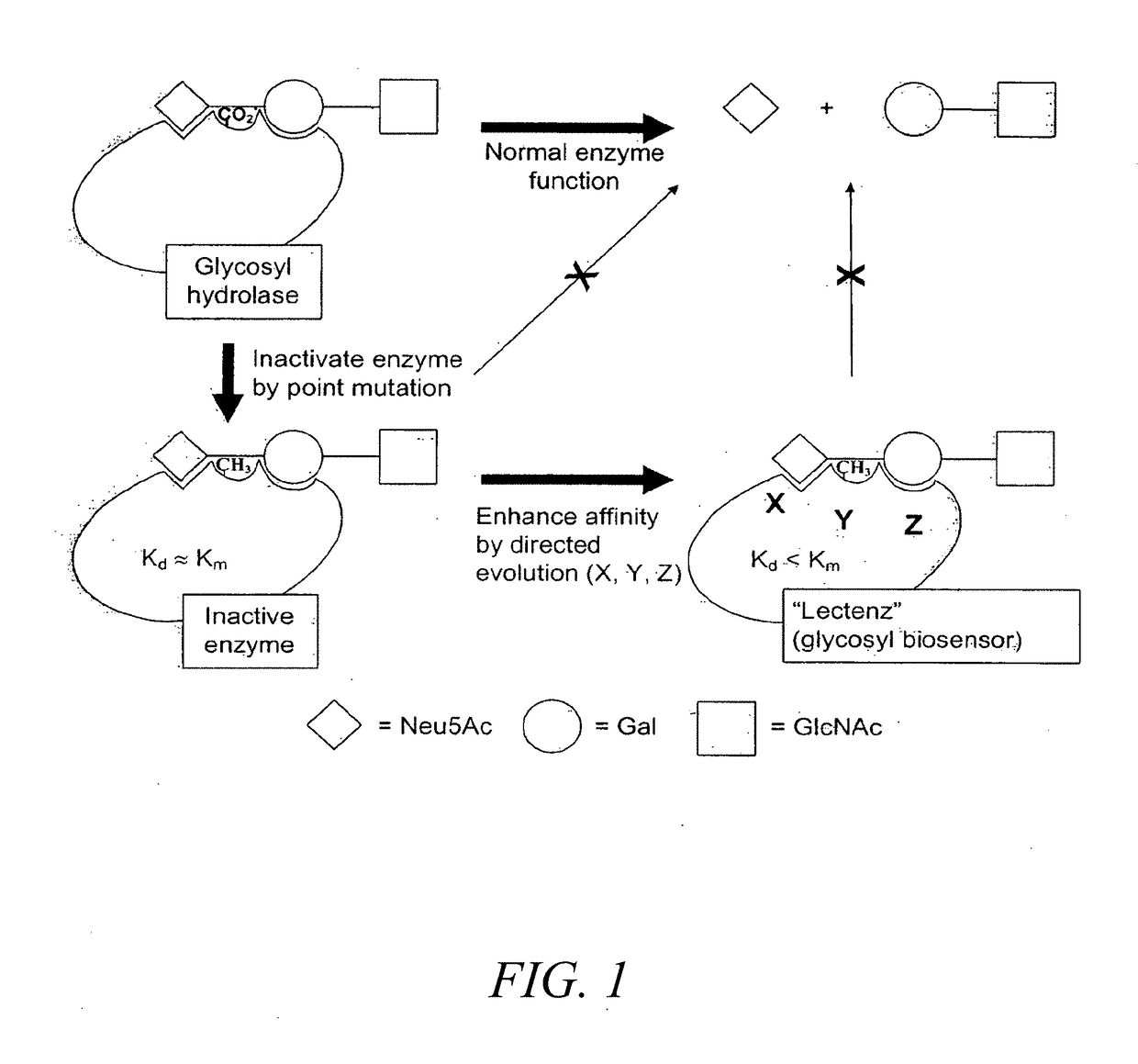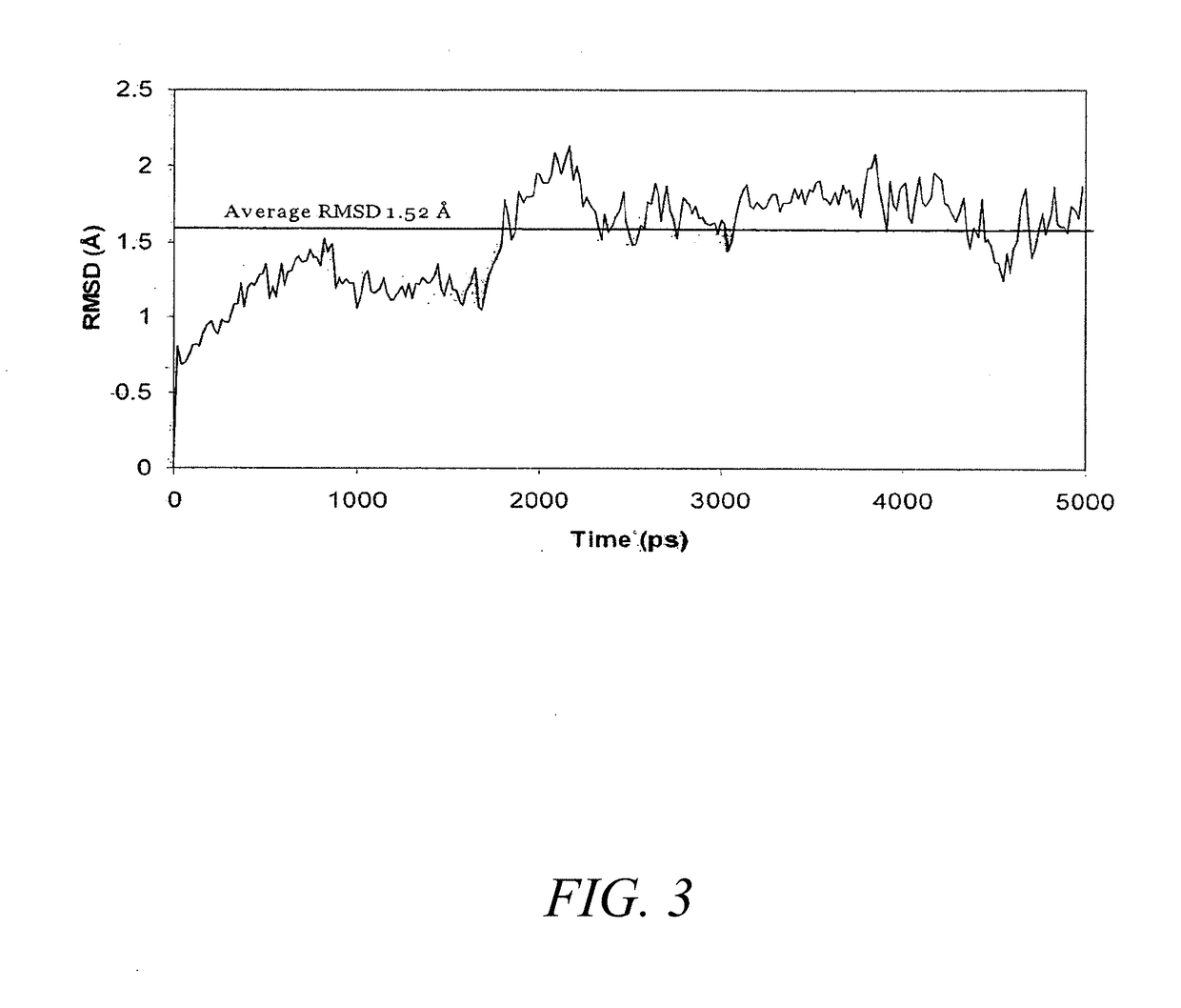Glycan-specific analytical tools
- Summary
- Abstract
- Description
- Claims
- Application Information
AI Technical Summary
Benefits of technology
Problems solved by technology
Method used
Image
Examples
example 1
Target Enzymes for Conversion to Lectenz
Target Enzymes for Conversion to Carbohydrate-Biosensors (Lectenz)
[0214]Presented in Table 1 are three initial glycosidases that can be subjected to redesign as lectenz. Lectenz 1 will find broad use in all aspects of glycomics analysis. Lectenz 2 will be vital to furthering the analysis of glycans in diabetes, and lectenz 3 will be useful in characterizing human versus avian influenza receptors.
TABLE 1Initial target enzymes for conversion to carbohydrate-biosensors (Lectenz)Source / RecombinantLectenzExpressionAvailableIDEnzymeSpecificityVectorStructure1PNGase F, Peptide-N4-N-linkedF. meningosepticum / X-ray (b)(acetyl-β-D-oligosaccharides (a)[E. coliglucosaminyl)-asparagine amidase2β-O-GlcNAcase, N-O-linked β-GlcNAc,B. thetaiotaomicron / X-ray (d)acetyl-β-D-monosaccharide (c)E. coliglucosaminidase3Neuraminidase, N-Terminal non-C. perfringens / Comparativeacetyl-neuraminatebranched α-(2,3) andE. colimodel (f)glycohydrolaseα-(2,6)-Neu5Ac (e)Additional...
example 2
Directed Evolution of Lectenz
[0239]A DNA library was created based on the inactive D60A mutant of the PNGase F enzyme. The residues D57, Y62, E118, S155, I156, G192, and E206 identified from computational analysis were randomized at the DNA level to encode for all twenty amino acids. The library was cloned into the yeast display vector pPNL6 and transformed into yeast.
[0240]The library was panned against dRNAse B captured on magnetic beads for two rounds then sorted for c-myc positive yeast by flow cytometry in the third round. The three rounds were repeated once for a total of six rounds. Table 8 shows the enrichment of yeast clones by sequencing the DNA of 18 clones from round six.
TABLE 8Enrichment of clones from round six.CloneRound 6 ClonesEnrichmentR6.1.73 / 18R6.1.124 / 18R6.1.133 / 18
[0241]Clone R6.1.13 was selected for functional analysis using a competition assay and was expressed in bacteria and purified. In the assay, 50 μL of a 1 μM solution of R6.1.13 was preincubated with dR...
example 3
Preparation of Beads
[0243]Multiplex beads were purchased from Spherotech (Lake Forest, Ill.). Lectins were purchased from Vector Labs and EYLabs and conjugated to the beads using standard coupling chemistry with EDC (1-ethyl-3-[3-dimethylaminopropyl] carbodimide hydrochloride) and Sulfo-NHS (N-hydroxysulfosuccinimide). Glycans will be obtained from commercially available sources. In a typical assay, 200 nM carbohydrate solutions are preincubated with 50 nM SA-Alexa Fluor 488 for 30 minutes in 50 μL total volume. 20,000 of each bead is added and incubated for 30 minutes. The beads are then washed and fluorescence intensity measured by flow cytometry. Binding analyses will be performed as described previously (Nolan et al., 2006, Curr Protoc Cytom; Chapter 13: Unit 13.8; Yang and Nolan, 2007, Cytometry A; 71(8):625-31; Nolan and Yang, 2007, Brief Funct Genomic Proteomic; 6(2):81-90).
[0244]For standardization of bead preparations the performance of each batch of MSA reagents will be co...
PUM
| Property | Measurement | Unit |
|---|---|---|
| Molecular strain energy | aaaaa | aaaaa |
| Volume | aaaaa | aaaaa |
| Fraction | aaaaa | aaaaa |
Abstract
Description
Claims
Application Information
 Login to View More
Login to View More - R&D
- Intellectual Property
- Life Sciences
- Materials
- Tech Scout
- Unparalleled Data Quality
- Higher Quality Content
- 60% Fewer Hallucinations
Browse by: Latest US Patents, China's latest patents, Technical Efficacy Thesaurus, Application Domain, Technology Topic, Popular Technical Reports.
© 2025 PatSnap. All rights reserved.Legal|Privacy policy|Modern Slavery Act Transparency Statement|Sitemap|About US| Contact US: help@patsnap.com



